- Home
- keyboard_arrow_right Phelan Dental Seminars
- keyboard_arrow_right One critical step to transform your smile design cases for your patients.
One critical step to transform your smile design cases for your patients.
Dr Stephen Phelan July 11, 2015

I wanted to write a blog post to teach you about a critical step that I feel will really transform your smile design cases for your patients.
When I look back at all of the beautiful smiles that I am fortunate to create for my patients I concluded that one of the steps in my system that has been critical to success is the provisional evaluation appointment.
We all know that the provisional restorations are critical for the ceramist to use as the guide when creating the final porcelain restorations. The potential for a problem happens because the provisional is the last step for the preparation appointment and if you are running out of time can be rushed or not properly evaluated. This is compounded by the patient having a lack of natural lip mobility due to any remaining local anesthetic and fatigue from the entire preparation, impression and provisional process. At this stage of the appointment, many patients just want to get out of the chair.
With all of this in mind I added a provisional evaluation appointment as a critical step in my system for smile design and rehabilitation cases.
I have been using this appointment for the last 18 years and it has allowed both myself and the patient a more relaxed and ideal time together to evaluate not only the occlusion but the esthetics of the provisional results.
This appointment is the time to make any changes in the occlusion design and incisal edge position BEFORE the ceramist starts to build the final restorations.
My system is to have the patient return anywhere from 1 to 2 weeks after the preparation date and evaluate the provisional results and make any desired changes to the case. If the provisional looks great or the changes are minor I will take a final provisional impression, bite records and digital photo series of the provisional results.
If the changes are significant I will have the patient go a few more weeks to evaluate the changes and then have a second provisional evaluation appointment.
I would like to share a recent case with you that illustrates a good lesson.
This patient was treatment planned for 7 Emax restorations for the maxillary anterior.
The first step after the functional analysis and treatment planning was to alter the gingival tissue levels.
After healing a new maxillary model was taken and mounted on the Sam 3 articulator to complete the diagnostic wax-up.
The patient came into the office for the preparation appointment and the old restorations were removed, new core build-ups placed and the final preparation impression and provisional restorations were created.
The patient returned to my office 2 weeks later for the provisional evaluation appointment. Due to traffic issues the patient was very late for this appointment but he told me that he was very happy with the results of the provisional restorations.
With this in mind I took a quick look at the results and decided it looked good to me as well. I checked the occlusion, discussed the shade and took the digital photo series. I then left the case with my assistant to take the final impression of the provisional.
The next day I was looking over the models and photos of the case preparing everything to send to my master ceramist, Harald Heindl. At this point I realized that I missed the fact that the incisal edge position was slightly canted and down on the right side. Even with the patient being late I should have taken more time on the provisional evaluation appointment.
The patient told me the day before that he was happy with these results but when I reviewed them I realized that this could be dramatically improved.
The decision was made to bring the patient back for a second provisional evaluation appointment so I could shorten the right side and level out the incisal edge position.
In a case like this one where the change is not that extensive I will shorten the incisal edge on the right side with Soflex XT discs, reevaluate the results and retake the provisional records.
The case was then sent to Master Ceramist Harald Heindl and completed with layered Emax crowns.
The moral of this story is that a critical evaluation of the provisional restorations is important for our cases even if the patient is late or you are behind and have a patient waiting in another chair.
Let me know if you have any questions or comments using the link above this post and if you like the written blog post format.
Thank you again for being a member of my online community and remember, you can do this kind of dentistry! Beautiful dentistry with precise fit and occlusion is not just for the gurus.
All the best, Stephen
Tagged as: Dentistry, digital smile design, smile design, white teeth, dental, Occlusion Design, Teeth, oakville dentist, cosmetic dentistry toronto, Dental Restorations, Dental Implant, Full Mouth Rehabilitation, Dental Occlusion, Dental Education, Phelan Dental Seminars, Dr. Stephen Phelan.
Post comments (12)
© Copyright Phelan Dental Seminars I Dr. Stephen Phelan

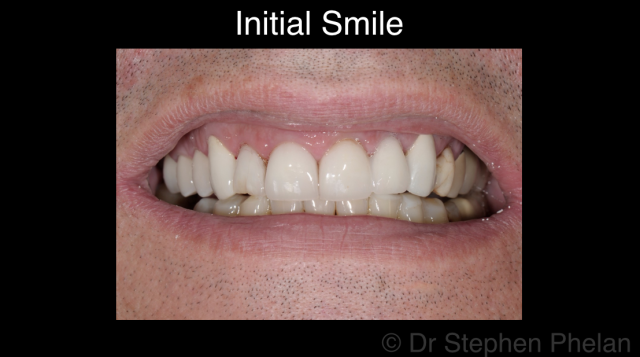
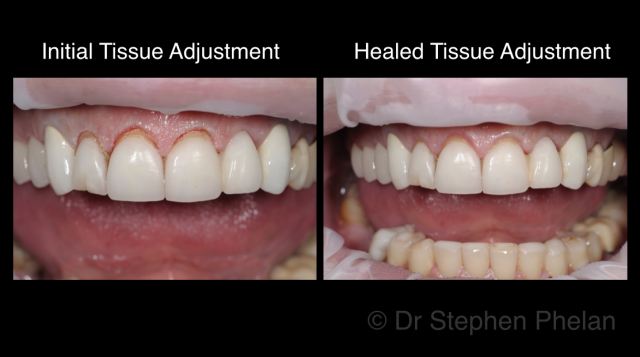
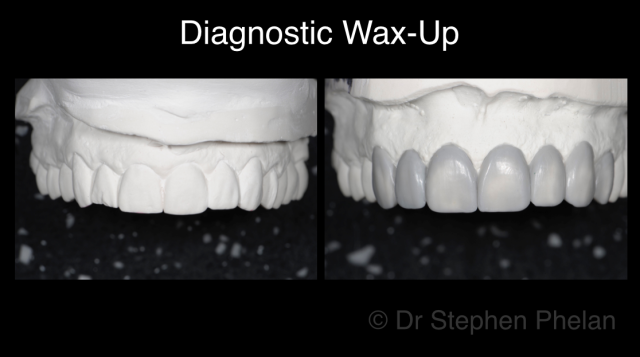
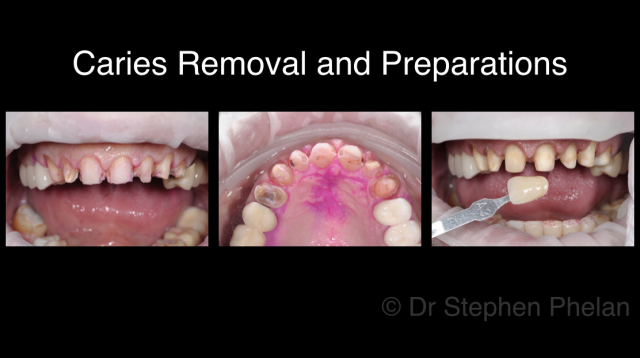
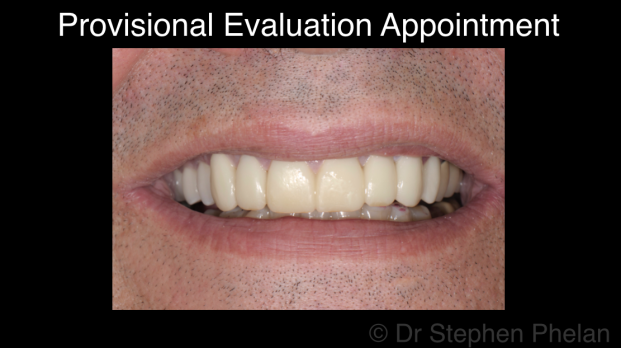
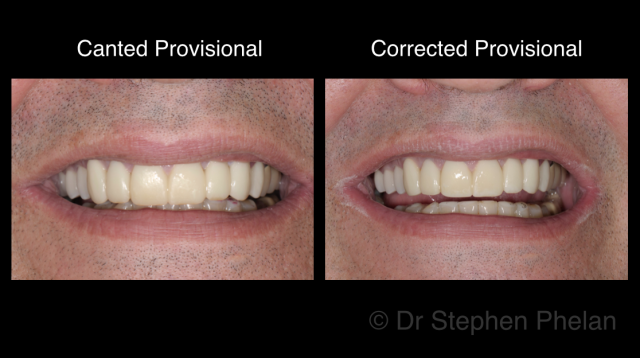
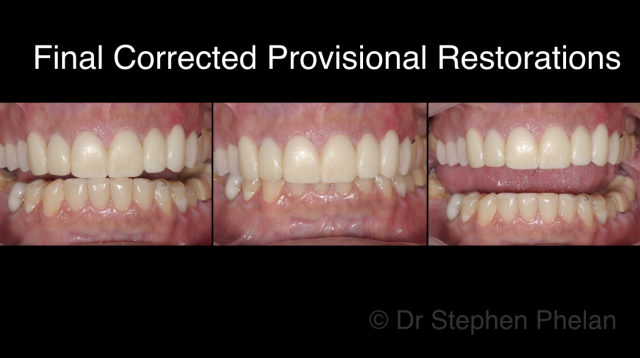
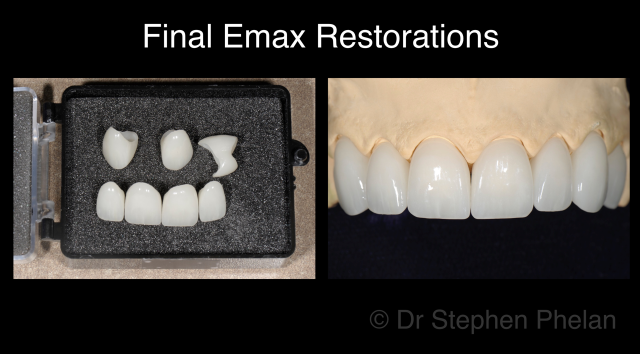
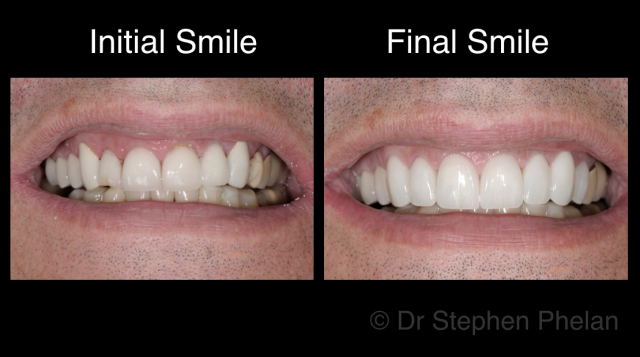
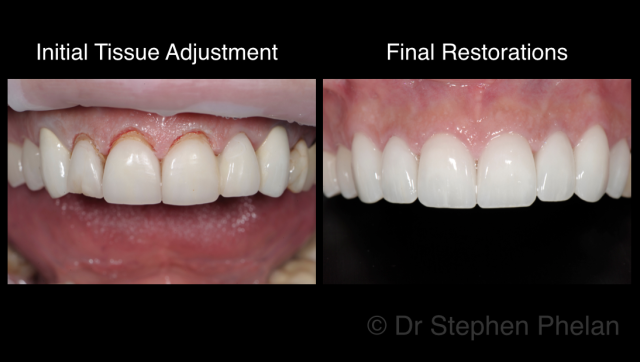


Aarthi on July 14, 2015
Hello Dr. Phelan
The step that you described is truly an important step. That is a beautiful presentation. It almost makes it look effortless. I can only imagine the amount of time you spent analyzing the case. On that note, I need your opinion for one of the cases that I am currently going to be starting. Pt is 60 years old. She has no upper teeth and lower bicuspid and canine only both sides. We treatment planned for lower bridge bicuspid to bicuspid and upper full denture. The pt is eventually getting implant retained upper denture or bridge not confirmed at this time.
my question to you is how would you start restoring this case in your opinion. Would you start with an upper denture or a lower bridge or both at the same time. the pt is struggling to find a bite since she has been edentulous for a very long time and has lost quite some bone. her lower lip is incompetent. it almost feels like I need to reprogram her lips and everything around her face before we give her some teeth.
Could you kindly give me some input as to how I can begin to restore this case.
On a positive note pt is aware that this is a challenging case as it is for me and is patient.
Thanks
Regards
Aarthi
Dr. Stephen Phelan on July 17, 2015
Thanks for the comments Aarthi. I do not manage very many fully edentulous patients because of my practice demographics but I would think the best option would be to test a new upper denture to the lower provisional restorations. That will give you better options to make any changes before the porcelain restorations are completed.
Dr. Samir Nayyar on July 13, 2015
Hello Dr. Stephen
You’re really doing good work. I think you start thinking from where we people stop thinking and that is the real edge you’ve in you.
Good luck and keep it up sir.
Regards
Dr. Stephen Phelan on July 17, 2015
Thanks Samir!
Safrida hoesin on July 11, 2015
Dear Dr Phelan,
Excellent presentation…it really shows the standard procedures and its step by step. I appreciate to look at the result that in any improvement you take time to share with the patient, such as to choose coloured and length
of the anatomical tooth. I was wondering if patient ask differently, to create ‘bunny teeth’ and ‘whitened’ the replaced teeth (6/6 anterior teeth, upper/lower)… In what reasons dentist could responsible to fulfil this case. Thank you for sharing great cases.
Dr. Stephen Phelan on July 11, 2015
Thanks Safrida for your comments. I think that within reason we need to try and meet the patients expectations but I would try and advise them on a solution that results in an overall integration with the rest of their mouth, smile and occlusion.
Peter Pagano on July 11, 2015
Thanks Stephen! Your blog touches on the nuances involved in doing excellent rehabilitative cosmetic dentistry. Evaluation of the original anterior photos and study models enabled you to recognize the need to modify gingival heights.The soft tissue architecture can make or break a case especially if there is a high smile line.
A provisional evaluation appointment makes sense. It allows time for the Dr. and patient to tweak the smile design and recapture this with a new impression, bite and photos. In this case your attention to detail and willingness to take and review photos of the provisionals allowed you to take this case from good to excellent.
I am frequently in that scenario you described about rushing to make the provisional at appointment end and the patient anxious to go. There is a leap of faith that the provisional is valid as-is without any further evaluation.This additional appointment handles my queasiness and provides the missing link to an excellent result! Great photos!
Dr. Stephen Phelan on July 11, 2015
Thanks Peter, I realized in the 90’s that the provisional evaluation appointment is critical and it has really enabled my case results to be at a higher level due to this extra time put into evaluating the case. The rushed feeling is something I believe we all experience and that is why I wanted to write this post. Thanks again for your feedback!
joseph shedlarski on July 11, 2015
Thank you for the video. I remember seeing this initially about 2 or 3 years ago when I took your course. Tissue management is so important, and, when you evaluate the problem, it becomes the management of spatial relations, through “fill in and push” tissue techniques. Going through each step with concern and diligence is the hallmark of success in aesthetic dentistry. Thanks again for demonstrating a valuable technique.
Dr. Stephen Phelan on July 11, 2015
Thanks for your comments Joseph and I am happy you benefited from my course! All the best with your cases!
Tejumade St Matthew-Daniel on July 11, 2015
I love your thought pattern in this post and this is 100% true!
The provisional post op visit is an appointment we can’t afford to skip and it makes or breaks the case indeed!
Thank you for helping to elevate our clinical mastery!
Dr. Stephen Phelan on July 11, 2015
Thanks for your comments Tejumade. I really appreciate yours and everyones feedback about this blog post!